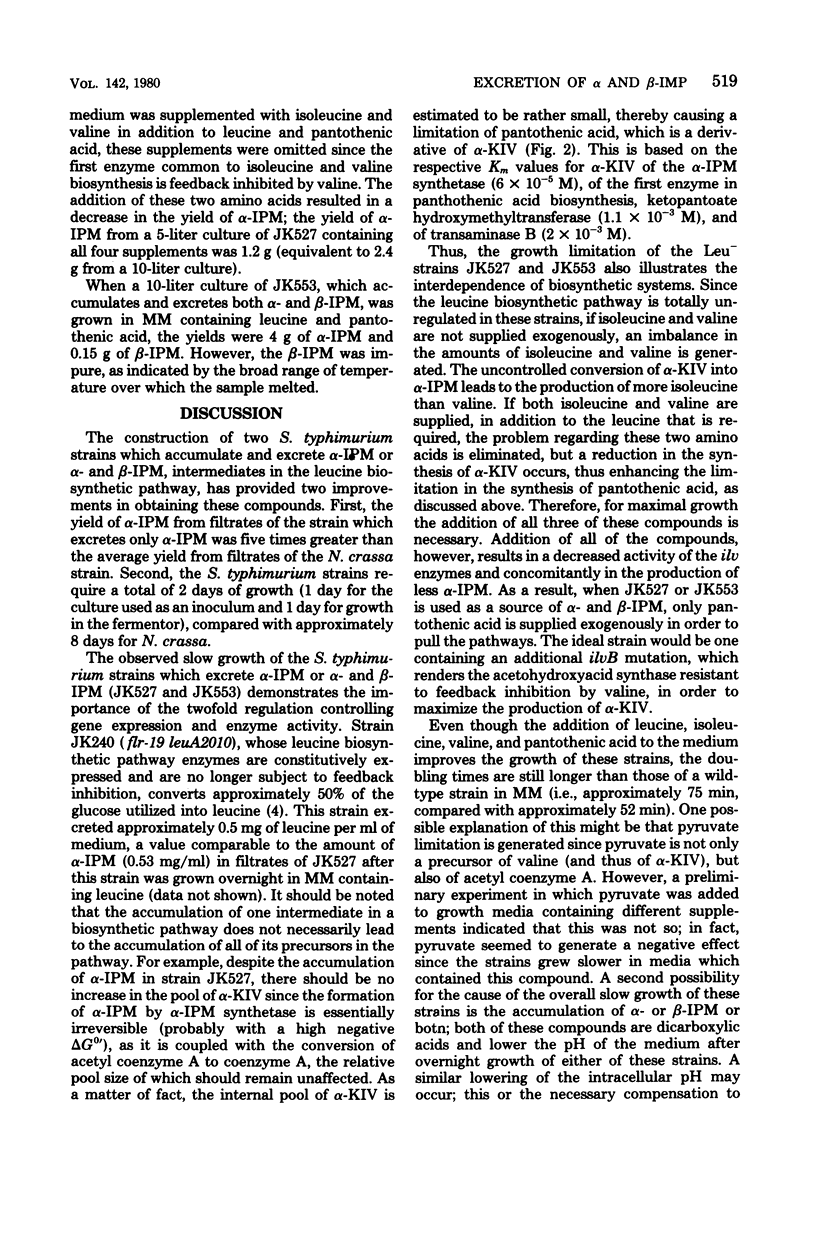Abstract
Two Salmonella typhimurium strains, which could be used as sources for the leucine biosynthetic intermediates α- and β-isopropylmalate were constructed by a series of P22-mediated transductions. One strain, JK527 [flr-19 leuA2010 Δ(leuD-ara)798 fol-162], accumulated and excreted α-isopropylmalate, whereas the second strain, JK553 (flr-19 leuA2010 leuB698), accumulated and excreted α- and β-isopropylmalate. The yield of α-isopropylmalate isolated from the culture medium of JK527 was more than five times the amount obtained from a comparable volume of medium in which Neurospora crassa strain FLR92-1-216 (normally used as the source for α- and β-isopropylmalate) was grown. Not only was the yield greater, but S. typhimurium strains are much easier to handle and grow to saturation much faster than N. crassa strains. The combination of the two regulatory mutations flr-19, which results in constitutive expression of the leucine operon, and leuA2010, which renders the first leucine-specific biosynthetic enzyme insensitive to feedback inhibition by leucine, generated limitations in the production of valine and pantothenic acid. The efficient, irreversible, and unregulated conversion of α-ketoisovaleric acid into α-isopropylmalate (α-isopropylmalate synthetase Km for α-ketoisovaleric acid, 6 × 10−5 M) severely restricted the amount of α-ketoisovaleric acid available for conversion into valine and pantothenic acid (ketopantoate hydroxymethyltransferase Km for α-ketoisovaleric acid, 1.1 × 10−3 M; transaminase B Km for α-ketoisovaleric acid, 2 × 10−3 M).
Full text
PDF







Selected References
These references are in PubMed. This may not be the complete list of references from this article.
- Burns R. O., Calvo J., Margolin P., Umbarger H. E. Expression of the leucine operon. J Bacteriol. 1966 Apr;91(4):1570–1576. doi: 10.1128/jb.91.4.1570-1576.1966. [DOI] [PMC free article] [PubMed] [Google Scholar]
- Calhoun D. H. Autoregulation of gene expression. Annu Rev Microbiol. 1975;29:275–299. doi: 10.1146/annurev.mi.29.100175.001423. [DOI] [PubMed] [Google Scholar]
- Calvo R. A., Calvo J. M. Lack of end-product inhibition and repression of leucine synthesis in a strain of Salmonella typhimurium. Science. 1967 May 26;156(3778):1107–1109. doi: 10.1126/science.156.3778.1107. [DOI] [PubMed] [Google Scholar]
- Fultz P. N., Kwoh D. Y., Kemper J. Salmonella typhimurium newD and Escherichia coli leuC genes code for a functional isopropylmalate isomerase in Salmonella typhimurium-Escherichia coli hybrids. J Bacteriol. 1979 Mar;137(3):1253–1262. doi: 10.1128/jb.137.3.1253-1262.1979. [DOI] [PMC free article] [PubMed] [Google Scholar]
- GROSS S. R., BURNS R. O., UMBARGER H. E. THE BIOSYNTHESIS OF LEUCINE. II. THE ENZYMIC ISOMERIZATION OF BETA-CARBOXY-BETA-HYDROXYISOCAPROATE AND ALPHA-HYDROXY-BETA-CARBOXYISOCAPROATE. Biochemistry. 1963 Sep-Oct;2:1046–1052. doi: 10.1021/bi00905a023. [DOI] [PubMed] [Google Scholar]
- Glatzer L., Eakin E., Wagner R. P. Acetohydroxy acid synthetase with a pH optimum of 7.5 from Neurospora crassa mitochondria: characterization and partial purification. J Bacteriol. 1972 Oct;112(1):453–464. doi: 10.1128/jb.112.1.453-464.1972. [DOI] [PMC free article] [PubMed] [Google Scholar]
- Huseby N. E., Stormer F. C. The pH 6 acetolactate-forming enzyme from Aerobacter aerogenes. The effect of 2-oxobutyrate upon the enzyme activity. Eur J Biochem. 1971 May 28;20(2):215–217. doi: 10.1111/j.1432-1033.1971.tb01382.x. [DOI] [PubMed] [Google Scholar]
- Kemper J. Evolution of a new gene substituting for the leuD gene of Salmonella typhimurium: characterization of supQ mutations. J Bacteriol. 1974 Sep;119(3):937–951. doi: 10.1128/jb.119.3.937-951.1974. [DOI] [PMC free article] [PubMed] [Google Scholar]
- Kohlhaw G., Leary T. R., Umbarger H. E. Alpha-isopropylmalate synthase from Salmonella typhimurium. Purification and properties. J Biol Chem. 1969 Apr 25;244(8):2218–2225. [PubMed] [Google Scholar]
- LOWRY O. H., ROSEBROUGH N. J., FARR A. L., RANDALL R. J. Protein measurement with the Folin phenol reagent. J Biol Chem. 1951 Nov;193(1):265–275. [PubMed] [Google Scholar]
- O'Neill J. P., Freundlich M. Temperature-sensitive growth inhibition by valine in Salmonella typhimurium: alteration of one form of acetohydroxy acid synthetase. J Bacteriol. 1973 Oct;116(1):98–106. doi: 10.1128/jb.116.1.98-106.1973. [DOI] [PMC free article] [PubMed] [Google Scholar]
- O'Neill J. P., Freundlich M. Two forms of biosynthetic acetohydroxy acid synthetase in Salmonella typhimurium. Biochem Biophys Res Commun. 1972 Jul 25;48(2):437–443. doi: 10.1016/s0006-291x(72)80070-6. [DOI] [PubMed] [Google Scholar]
- Powers S. G., Snell E. E. Ketopantoate hydroxymethyltransferase. II. Physical, catalytic, and regulatory properties. J Biol Chem. 1976 Jun 25;251(12):3786–3793. [PubMed] [Google Scholar]


